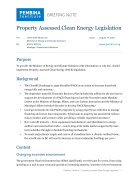Along with its Pacific Coast Collaborative partners—the states of California, Oregon and Washington—British Columbia has committed to “lead the way to ‘net-zero’ buildings.” Buildings where energy use has been reduced to a level such that it could be generated on site, are often labelled as “ultra-low energy” or “net-zero ready." While this is an admirable commitment, B.C. has yet to define its net-zero target and articulate a plan to get there. This paper looks specifically at the necessary components of a roadmap to make new complex (Part 3) buildings net-zero ready. It describes the environmental and economic case for a deep efficiency pathway, reviews some of the targets and policies adopted in leading jurisdictions, and then articulates ten key policies to get to “net-zero ready”.
To learn more about the role and history of building regulations in accelerating energy efficiency in B.C., read the first paper in this series: Evolution of Energy Efficiency Requirements in the B.C. Building Code.






